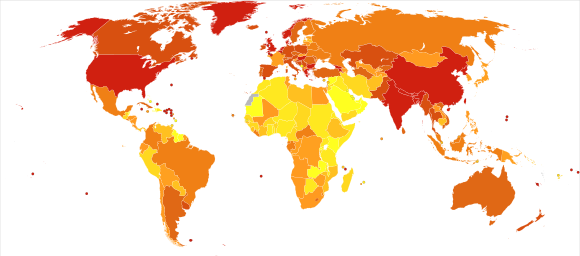Chronic Obstructive Pulmonary Disease
Chronic Obstructive Pulmonary Disease (COPD) is a progressive lung disease characterised by long-term respiratory symptoms and airflow limitation. It includes chronic bronchitis and emphysema, which often coexist and lead to persistent airflow obstruction.
COPD is predominantly caused by tobacco smoking but can also result from air pollution, occupational irritants, and genetic factors such as alpha-1 antitrypsin deficiency.

Signs and Symptoms
The main symptoms of COPD are shortness of breath and a chronic cough, which may produce mucus. Patients often experience progressive breathlessness, chest tightness, wheezing, and reduced physical activity.
The severity of symptoms can vary, and exacerbations, characterised by sudden worsening, often occur due to infections or environmental pollutants. Chronic bronchitis is marked by a productive cough lasting at least three months for two consecutive years, while emphysema involves the destruction of alveoli, leading to enlarged airspaces and reduced lung function.

Diagnosis
COPD is diagnosed through spirometry, which measures airflow obstruction. Key parameters include the forced expiratory volume in one second (FEV1) and the forced essential capacity (FVC).
A FEV1/FVC ratio less than 70% confirms the presence of COPD. Additional assessments may include chest X-rays to exclude other conditions, CT scans for detailed imaging, and blood gas analysis for evaluating oxygen and carbon dioxide levels.
Screening for alpha-1 antitrypsin deficiency is recommended for all COPD patients.

Treatment
COPD management includes lifestyle modifications, pharmacological interventions, and in severe cases, surgical options. Smoking cessation is very important to slowing disease progression.
Pharmacological treatments involve inhaled bronchodilators (short-acting and long-acting), inhaled corticosteroids, and phosphodiesterase-4 inhibitors like roflumilast. Long-term oxygen therapy may be necessary for patients with chronic respiratory failure.
Pulmonary rehabilitation programmes, which include exercise training, nutritional advice, and education, improve the quality of life. Acute exacerbations are treated with increased bronchodilator use, corticosteroids, and antibiotics if bacterial infection is suspected.
Advanced cases may require lung volume reduction surgery or lung transplantation.
Complications and Comorbidities
COPD is often accompanied by comorbidities such as cardiovascular disease, skeletal muscle dysfunction, metabolic syndrome, osteoporosis, depression, and anxiety. Complications include respiratory infections, pulmonary hypertension, cor pulmonale, and respiratory failure.
Low oxygen levels and systemic inflammation are common in COPD patients, contributing to a poor prognosis.
Prevention
Preventive measures focus on reducing exposure to risk factors. This includes smoking cessation programmes, improving indoor and outdoor air quality, and using protective equipment in occupational settings.
Vaccinations for influenza and pneumococcal infections are recommended to prevent exacerbations. In developing countries, reducing indoor air pollution from biomass fuels is essential.
Epidemiology
Globally, COPD affects approximately 174.5 million people and caused 3.2 million deaths in 2019. It is more common in people over 35 years of age, with higher prevalence in men, though the rate in women is increasing due to changing smoking patterns.
The economic burden of COPD is significant, with high healthcare costs and loss of productivity.

Research
Ongoing research is looking at new treatments, including stem cell therapy, targeted lung denervation, and innovative medications. Preventive strategies and better diagnostic tools are also being developed to improve patient outcomes and reduce the burden of COPD worldwide.
Self-assessment MCQs (single best answer)
Which of the following is the most common cause of Chronic Obstructive Pulmonary Disease (COPD)?
Which symptom is most characteristic of COPD?
What diagnostic test is essential for confirming a diagnosis of COPD?
Which of the following is a primary goal in the management of COPD?
Which medication is commonly used as a first-line maintenance treatment in COPD cases with repeated exacerbations?
In which stage of COPD is long-term oxygen therapy typically recommended?
Which lifestyle change is most effective in slowing the progression of COPD?
What is the main cause of exacerbations in COPD patients?
Which imaging method is most commonly used to exclude other conditions when diagnosing COPD?
COPD often coexists with which other condition?
Dentaljuce
Dentaljuce provides Enhanced Continuing Professional Development (CPD) with GDC-approved Certificates for dental professionals worldwide.
Founded in 2009 by the award-winning Masters team from the School of Dentistry at the University of Birmingham, Dentaljuce has established itself as the leading platform for online CPD.
With over 100 high-quality online courses available for a single annual membership fee, Dentaljuce offers comprehensive e-learning designed for busy dental professionals.
The courses cover a complete range of topics, from clinical skills to patient communication, and are suitable for dentists, nurses, hygienists, therapists, students, and practice managers.
Dentaljuce features Dr. Aiden, a dentally trained AI-powered personal tutor available 24/7 to assist with queries and provide guidance through complex topics, enhancing the learning experience.
Check out our range of courses, or sign up now!


